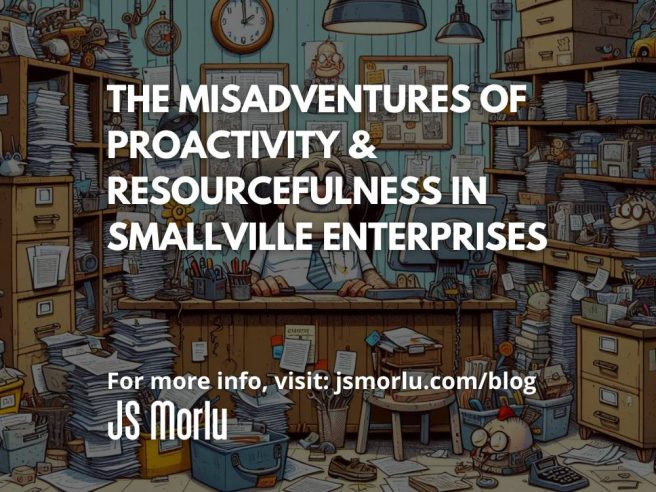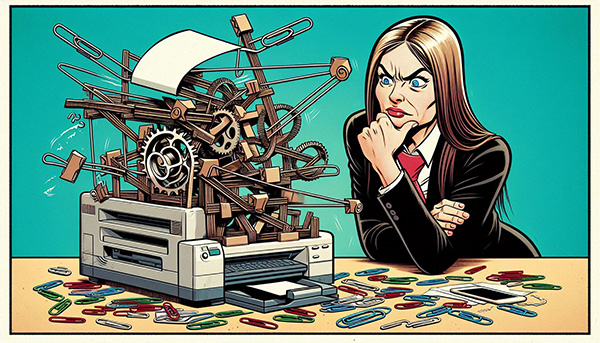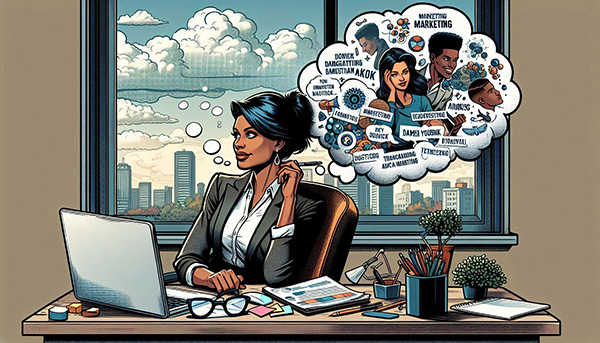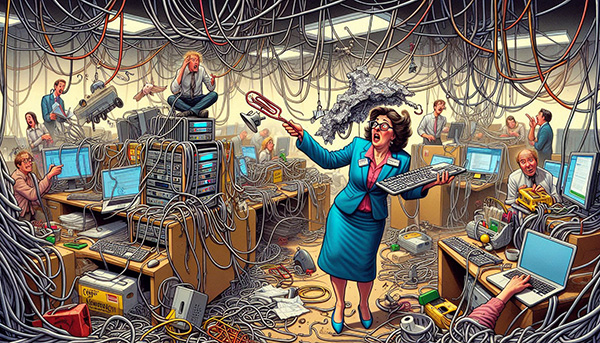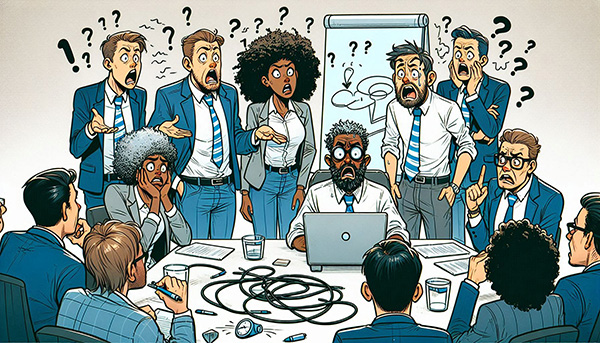By: John S. Morlu II, CPA
Introduction
In the quaint, unassuming town of Smallville, far from the hustle and bustle of major corporate hubs, sat a peculiar little company: Smallville Enterprises. Despite its modest size, the business was loud in its declarations of innovation and unshakable confidence. With grand slogans like “Innovating Solutions” and “Embracing Challenges,” Smallville Enterprises proudly positioned itself as a beacon of proactivity and resourcefulness. On paper, it was a shining example of entrepreneurial ambition—a small business punching above its weight, navigating obstacles with creativity and drive.
But beneath this polished exterior lurked a much different reality. Behind closed doors, Smallville Enterprises was not the paragon of problem-solving efficiency it claimed to be. In fact, it was teetering on the edge of chaos. What should have been a showcase of agility and innovation had devolved into a cautionary tale—a business where misguided proactivity often turned small hiccups into catastrophic failures. Their attempts at resourcefulness, rather than being effective, often backfired, turning routine tasks into dramatic ordeals.
At the heart of this unraveling were the company’s well-meaning but wildly misguided employees, each one an eccentric character in their own right. Together, they created an environment where minor workplace inconveniences escalated into full-blown crises, as their eagerness to “do something” often led them into traps of their own making. What was once a thriving business soon became a cautionary tale of how not to run a company—a perfect example of the chaos that ensues when proactivity and resourcefulness go unchecked, unstructured, and unexamined.
As Smallville Enterprises began to crack under the weight of its own ambition, the once-optimistic team found itself lost in a tangle of well-intentioned but disastrous solutions. Welcome to the twisted saga of Smallville Enterprises—a tale of overzealous employees, inflated problems, and a business that exemplified the dangerous side of unchecked enthusiasm.
The Cast
Carl Cumbersome: The well-meaning but hopelessly delusional CEO, Carl believed with every fiber of his being that proactivity could solve any problem—even if that meant inventing problems just to solve them. Fueled by TED Talks and a Pinterest board full of business clichés, Carl’s obsession with buzzwords like “disruption” and “innovation” often sent the company spiraling down ridiculous rabbit holes. He was the kind of leader who believed that holding a daily “Innovation Hour” would somehow cure Smallville’s sinking profits—whether or not anyone actually participated.
Pamela Paperclip: Self-appointed “Chief Resourceful Officer” (a title she printed herself), Pamela was a living testament to the idea that you could make something out of nothing—literally. Why use a stapler when you could bend three paperclips together and invent a new, but completely unnecessary, office tool? To Pamela, resourcefulness meant re-engineering simple tasks into elaborate, Rube Goldberg-style productions that rarely worked but always impressed—for about five seconds. Her motto? “Why solve a problem when you can repurpose a paperclip?” And that’s exactly how the company ended up with a 50-step process to brew coffee.
Oliver Overdo: The operations manager who believed in one thing: if you’re not over-preparing, you’re underachieving. Oliver had a special talent for turning the simplest task into a logistical nightmare. Filing a report? Better organize a full-day workshop on document management first. Ordering office supplies? Cue the six-month vendor evaluation process. His obsession with overkill meant that Smallville’s operations were less about efficiency and more about surviving Oliver’s ever-expanding maze of policies, flowcharts, and checklists.
Lily Linger: The perpetually inspired marketing manager, Lily believed that true proactivity wasn’t about execution but rather about waiting for the perfect cosmic alignment of ideas. She loved to brainstorm—endlessly. Meetings with Lily were less about producing campaigns and more about “vibing” on what the next big trend might be—whenever it finally arrived. Of course, that day never came, but Lily was confident it would. Eventually. If she just waited a little longer. And took one more inspiration break. Or ten.
Sam Satisfactory: Sam’s approach to human resources was… well, less about humans and more about avoiding hard work. While everyone else scrambled to outdo themselves in the name of proactivity, Sam perfected the art of doing just enough to keep his desk warm. His mantra? “If it ain’t broken, don’t fix it—and if it is broken, just shrug.” Sam’s ability to coast through his job while the company around him imploded was his greatest strength—and somehow, his biggest contribution.
Chapter One: The Great Printer Crisis
It all began with something so mundane, so small, that no one could have predicted the catastrophe to follow: the office printer broke down. For any normal company, this would have been a blip on the radar, a quick call to tech support, and back to business. But at Smallville Enterprises, there was no such thing as a minor issue.
Carl Cumbersome, with his unwavering faith in proactivity and leadership, wasted no time. He slammed his hands on his desk, sprang to his feet, and bellowed across the office, “Emergency meeting! The printer is down, people! This is a chance for us to show our innovative spirit. I want proactive solutions, and I want them NOW!”
Within minutes, the team was gathered in the conference room as Carl paced dramatically in front of the malfunctioning machine. “This isn’t just about a broken printer,” he declared, eyes gleaming. “This is about our future! Our resilience! Our ability to disrupt the status quo!” His words echoed through the room, though no one was entirely sure why they were necessary.
Pamela Paperclip, ever eager to prove her title of “Chief Resourceful Officer,” leapt into action like a caffeinated squirrel. She raced around the office, gathering supplies from every nook and cranny—paperclips, rubber bands, binder clips, even the stapler from Carl’s desk.
“I’ve got this!” she chirped as she twisted a rubber band around the printer tray and began assembling a makeshift contraption. “We don’t need a repairman. We’ve got everything we need right here. Resourcefulness is the key!”
Pamela’s enthusiasm was boundless, but her technical knowledge was… nonexistent. What started as a minor inconvenience quickly escalated into a full-blown disaster. The once-functional (if slightly problematic) printer was now a Frankenstein’s monster of office supplies, completely inoperable. Her crowning achievement? A duct-taped pulley system that managed to snap the printer tray clean off.
“This is just a minor setback,” Pamela assured the team, holding up two rulers tied together with twine. “We’re making progress!”
But they were not. In fact, what could have been fixed with a $100 service call had morphed into a productivity black hole. Client deliverables were delayed, payroll was postponed, and crucial contracts were left unprinted. Chaos reigned.
As the printer crisis spiraled out of control, Oliver Overdo, the operations manager, saw this as his moment to shine. While everyone else was flailing, Oliver marched into the office with a thick stack of papers. “I’ve prepared a comprehensive plan to address the printer situation,” he said, standing as if he were about to deliver a TED Talk. “This is not just about fixing the printer—this is an opportunity to completely overhaul our printing infrastructure!”
He clicked through a 50-slide PowerPoint presentation, outlining his grand vision for Smallville Enterprises’ future. It involved purchasing industrial-grade printers, rewiring the office network, and hiring a consultant from a global printing efficiency firm. Oliver’s proposal was so exhaustive it included everything from detailed timelines to a 3-month “printer integration strategy,” with an optional team-building retreat to bond over their newfound printing capabilities.
“I’m ready to stay late every night until we get this right,” Oliver proclaimed, rolling up his sleeves dramatically, as though preparing to wage war on the humble inkjet.
Weeks passed, and the office descended into chaos. Contractors arrived to rewire the network, consultants conducted endless interviews with staff about their printing habits, and new printers the size of small refrigerators were wheeled into the building. The entire operation was so disruptive that no one noticed that the original problem could have been solved with a simple software update.
Carl, naturally, was thrilled with the “progress.” As workers navigated around half-assembled printer parts and tangled network cables, Carl smiled proudly. “This is what innovation looks like!” he announced to anyone within earshot, as though they were all participants in some grand experiment. “We’ve turned a crisis into an opportunity for growth!”
Meanwhile, the company’s budget hemorrhaged. Thousands of dollars were funneled into this grand printer transformation. Client complaints piled up. The IT team, normally unflappable, was on the verge of revolt. Even Sam Satisfactory, the human resources manager, raised an eyebrow as he shuffled through the paperwork for yet another contractor hire, muttering to himself, “This seems… a bit much.”
Eventually, after enough chaos to fill a sitcom season, someone—probably the office intern—realized the original printer’s issue wasn’t hardware-related at all. It just needed a simple software update. With a few clicks, the printer whirred back to life, perfectly functional once more.
But by then, the damage was done. Oliver’s multi-thousand-dollar overhaul had left the office with an entire room dedicated to over-the-top printing equipment no one knew how to use. Pamela’s paperclip monstrosity had been quietly swept into the trash. Carl had moved on to his next “opportunity for disruption” (something about reimagining the office coffee machine), and Smallville Enterprises’ bottom line was looking worse than ever.
All this, because no one thought to call the repairman.
Thus, the Great Printer Crisis became a legend at Smallville Enterprises, a cautionary tale whispered around the water cooler. It was proof that while proactivity and resourcefulness could be virtues, in the wrong hands, they were dangerous weapons.
Chapter Two: The Marketing Campaign Catastrophe
After the Great Printer Crisis, you would think Smallville Enterprises had learned its lesson about the dangers of unchecked creativity. But no, they were just getting started. The next grand disaster came courtesy of Lily Linger, the marketing manager with a tendency to mistake procrastination for inspiration.
Lily had one job: create a marketing campaign to boost sales. It seemed simple enough. But for Lily, simplicity was the enemy of brilliance. Instead of rolling up her sleeves and putting together a straightforward campaign, she opted for the more “enlightened” approach—doing absolutely nothing and waiting for inspiration to strike.
Lily spent the first week lounging in her office, gazing dreamily out of the window, as if the clouds might arrange themselves into the perfect slogan. When asked how the campaign was coming along, she’d nod sagely and say, “It’s all about timing. The universe will provide.” She said this while twirling her pen as though channeling cosmic wisdom directly through her fingertips.
Two weeks in, and still no campaign, Lily had moved on to “creative visualization,” which essentially involved lying on a yoga mat under her desk. “I’m letting the ideas come to me,” she explained to her increasingly concerned colleagues. She wasn’t entirely wrong—ideas did come to her. Unfortunately, they just weren’t related to the company’s actual business.
After an entire month of staring out of windows, sipping herbal tea, and conducting endless “brainstorming” sessions (which were really just lengthy coffee breaks), Lily finally had her big eureka moment. And it was nothing short of revolutionary—at least in Lily’s mind.
Her brilliant idea? A viral social media campaign centered around… staplers. Yes, staplers. Despite the glaring fact that Smallville Enterprises didn’t sell staplers, Lily was convinced this was the stroke of genius the company had been waiting for.
“We’ll personify staplers and create a series of posts about their adventures in exotic locations,” she explained with wide-eyed excitement at the next team meeting. She waved her hands dramatically, as if summoning the vision from the ether. “It’s not about what we sell; it’s about the lifestyle we represent! Staplers are just the beginning.”
Carl Cumbersome, still recovering from the Printer Crisis and desperately grasping for any glimmer of innovation, gave her the green light. “This is exactly the kind of disruption we need!” he declared, standing up to applaud Lily as if she had just discovered fire.
Within days, Lily’s stapler saga was in full swing. Thousands of dollars were funneled into the production of professional videos and photo shoots for the now-infamous “Stapler Stories” campaign. Staplers were shipped to the ends of the earth: lounging on tropical beaches, perched atop mountaintops, and even taking in the cultural sights at art museums. Each post was accompanied by inspirational quotes like “Fasten your life together, one click at a time” and “Stapling dreams into reality.”
Pamela Paperclip, true to her name, saw this as an opportunity to flex her resourcefulness. She dove headfirst into the project, creating custom accessories for the staplers. Soon, the staplers were sporting tiny sunglasses, scarves, and—because why not?—miniature capes. Pam had turned the office into a DIY craft corner, and everyone was too terrified to stop her.
“I think the stapler needs a jetpack,” Pam said one afternoon, as she affixed a pair of wings made from coffee filters onto a bewildered-looking stapler.
Meanwhile, the office hummed with the sound of creativity gone completely off the rails. The stapler in Venice post went live. Then the stapler on a safari. Staplers were bungee jumping, skydiving, and exploring the Great Wall of China, all in the name of “building a lifestyle brand.” It was madness.
But here’s the kicker: the public was utterly perplexed. Clients started calling in droves, asking if Smallville Enterprises had pivoted into selling stationery. “Are you a stapler company now?” asked one bewildered customer. “Do I get a free stapler with my service package?” another inquired, clearly unsure whether he should order office supplies or business solutions.
As staplers continued to travel the world, sales of the company’s actual services plummeted. Customers who needed the company’s core services—accounting, consulting, IT support—had no idea what Smallville Enterprises even did anymore. All they saw were staplers gallivanting around Paris in berets.
Carl, ever the optimist, continued to defend the campaign. “This is exactly what we need to go viral!” he insisted, ignoring the pile of client complaints stacking up on his desk. “Once people see the staplers, they’ll associate us with… well… creativity!”
But it wasn’t long before the reality hit: the campaign was a total disaster. The marketing budget had been drained, leaving nothing for actual promotional efforts. Worse yet, the entire company had become a laughingstock. Internally, employees took to calling themselves “Stapler Enterprises.” No one took them seriously anymore—how could they, when the company’s social media was flooded with images of staplers lounging in hammocks?
Lily, still convinced the campaign was a success, had moved on to new ideas, including “Paperclip Adventures” and “Binder Clips: The Untold Story.” But by that point, Carl had no choice but to pull the plug on her whimsical efforts.
“We’ve made some great memories,” Carl said during the emergency post-mortem meeting, “but perhaps staplers… weren’t the exact solution we were looking for.”
Pamela raised her hand sheepishly, holding up a stapler she had bedazzled earlier that day. “I mean, they’re still pretty resourceful…”
“No more staplers,” Carl said firmly, putting an end to the campaign that had cost the company its marketing budget, reputation, and a good portion of its sanity.
As the team dismantled the stapler-themed photo sets and stashed away the tiny sunglasses, the office was left with a sense of bewilderment. How had something so small spiraled into such a massive catastrophe? What started as a simple marketing campaign to boost sales had morphed into an elaborate, costly spectacle that did nothing but confuse clients and sabotage the company’s image.
The Stapler Stories campaign would go down in Smallville Enterprises history as the marketing blunder to end all blunders. But for Lily Linger, it was just another stepping stone on her endless quest for inspiration. “Next time,” she mused as she gazed thoughtfully out of the window, “maybe we’ll do something with rubber bands…”
And with that, Smallville Enterprises braced itself for the next inevitable chapter of over-the-top “innovation.” After all, when your marketing manager believes in the power of staring out the window long enough for the universe to whisper brilliance, what could possibly go wrong?
Chapter Three: The Proactive IT Meltdown
One seemingly ordinary afternoon, disaster struck Smallville Enterprises in the form of a Wi-Fi outage. For most businesses, this would be a minor inconvenience—a brief flicker of lost connectivity, easily fixed by rebooting the router or maybe giving it a gentle whack. But Smallville Enterprises was not most businesses. This hiccup in the wireless ether was perceived as a full-blown catastrophe—the kind that could bring down empires and unravel the very fabric of modern society. At least, that’s how Oliver Overdo saw it.
As soon as the Wi-Fi went down, Oliver sprang into action. He dramatically swept into the middle of the office like a general on the eve of battle, arms raised in apocalyptic declaration. “The network is down!” he announced with the gravitas of someone announcing the end of the world. “Our entire IT infrastructure is compromised!”
A lesser man might have just checked the router. But Oliver was not one for half-measures. No, in his eyes, this was the perfect opportunity to over-engineer a solution that no one had asked for.
“People, we are going to future-proof this company,” Oliver declared, rolling up his sleeves. “We’ll rebuild our system from the ground up—no more wireless nonsense! From now on, we hardwire everything. Cables, industrial-grade routers, fiber optics… the works!”
He grabbed a whiteboard and started drawing elaborate diagrams featuring wires crisscrossing the ceiling like an electrical spiderweb. He spoke in a language only he seemed to understand, mentioning things like “server redundancies,” “distributed cloud matrices,” and “quantum encryption.” His fervor was so intense, the team half-expected him to don a lab coat and start yelling, “It’s alive!”
Meanwhile, equipment orders started flooding in. Oliver splurged on shiny new servers, Ethernet cables long enough to stretch to the moon, and a backup generator “just in case the sun explodes.” When questioned about the cost, Oliver waved it off. “Can you really put a price on security and productivity?” he asked, oblivious to the fact that no one else thought the world was ending.
Not to be outdone, Pamela Paperclip, Smallville’s resident MacGyver, decided she could solve the problem without fancy equipment. Armed with the confidence of someone who’s watched a few too many DIY videos on YouTube, Pam constructed what she proudly called a “Wi-Fi booster.” It was a sight to behold: a coathanger wrapped in tin foil, taped to an old satellite dish she had scavenged from the alley behind the office. She mounted the contraption above the office doorway, stepping back with the smug satisfaction of someone who just singlehandedly invented wireless internet.
“I’m going to boost the signal with this!” she announced, as if unveiling a scientific breakthrough.
What followed was two days of absolute chaos. Pam’s tin-foil masterpiece did indeed “boost” something—just not the Wi-Fi signal. It somehow scrambled the entire network, blocking out not only the office’s internet but also mysteriously affecting the neighboring pizza place’s online orders. The result? Total blackout. Desperate employees were forced to tether their phones, work from coffee shops, or—horror of horrors—go outside to find functional Wi-Fi.
While Pam continued adjusting the angle of her coathanger dish, Oliver had moved on to Phase Two of his master plan. Cables began snaking through the ceilings, and contractors showed up unannounced to drill holes in walls and install enough routers to service a small city. He installed servers so advanced they could probably handle NASA’s Mars mission, all in the name of ensuring that Smallville Enterprises never experienced another Wi-Fi outage again.
The problem, however, persisted. And it wasn’t until an intern, Chad—the office’s quiet tech whiz—walked over to the router, unplugged it, waited ten seconds, and plugged it back in that the entire issue was resolved. In less than a minute, the Wi-Fi was back online, leaving Oliver and Pam staring in disbelief.
“Did you just—?” Oliver began, unable to comprehend the simplicity of the solution.
“Yep. Just rebooted it,” Chad said with a shrug, as though this was the most obvious thing in the world. And it was—at least to everyone except Oliver and Pam.
But by this point, the damage had been done. Weeks of productivity had been lost to Pam’s aluminum monstrosity and Oliver’s overzealous rewiring. Clients, confused by the radio silence, had started questioning whether Smallville Enterprises was still in business. The employees, meanwhile, had grown used to working out of coffee shops, where at least they could enjoy free Wi-Fi and overpriced lattes while they tried to explain to clients why their emails were going unanswered.
Carl, still recovering from the Stapler Stories debacle, was exasperated when he found out how much money had been spent. “Oliver,” he said, rubbing his temples, “we could have just… rebooted the router.”
“Yes, but now we’re future-proofed!” Oliver said proudly, gesturing to the server room, which was now home to enough blinking lights and humming machines to impress even a Star Trek engineer.
In the end, the company was left with a cutting-edge IT setup that it didn’t need, a massive dent in the budget, and employees who had learned to tether their phones faster than you could say “router reboot.” Pam’s signal booster was dismantled (although she swore it had almost worked), and Oliver continued to lurk around the server room like a mad scientist waiting for his next opportunity to “save the company from itself.”
And so, the Wi-Fi outage—a minor issue that could have been resolved in seconds—became yet another chapter in the saga of Smallville Enterprises’ ability to turn molehills into mountains. Or, in this case, into a mountain of unnecessary server equipment.
But hey, at least the pizza place’s Wi-Fi was finally back. And really, isn’t that the most important thing?
Chapter Four: The Reckoning
Smallville Enterprises, once an oasis of quirky proactivity and over-the-top ingenuity, had become a tragicomedy of its own making. Each crisis, from the Stapler Stories debacle to the Great Wi-Fi Meltdown of ’23, had left the company deeper in debt, confusion, and collective eye-rolling. If there was a way to turn a simple issue into a full-scale catastrophe, Smallville had found it—and then bought a five-year warranty for it.
Carl, once the beacon of unrelenting optimism, was now the captain of a sinking ship. He had spent months obsessing over being “proactive and resourceful,” convinced that if everyone just thought a little harder and tried a little longer, Smallville would stumble upon its golden ticket. But instead, the company had stumbled into chaos, tripping over one well-intentioned mess after another.
In the far corner of the office, Pam was still fiddling with what appeared to be a stapler converted into a mobile phone charger, muttering something about “multi-purpose office supplies.” Oliver, never one to be outdone, was drafting blueprints for a company-wide pneumatic tube system, arguing that emails were “too slow” and that message tubes would “put them ahead of the curve.” Sam, true to his nature, sat in the background, quietly Googling ways to optimize his Netflix streaming while half-listening to the madness unfold. Lily, of course, was lost in a new brainstorming session about a viral TikTok campaign featuring paperclips doing yoga.
But it was Carl, seated in his office one evening, who felt the weight of it all. His desk, once neatly organized with motivational posters and crisp notepads, now resembled a battlefield. He sifted through the wreckage of failed ideas and over-engineered solutions, his gaze drifting to the motivational poster on the wall that had once filled him with such misguided hope. “Proactivity is the key to success,” it declared, the words now seeming more like a cruel joke than sage advice.
Carl took a deep breath and ripped the poster off the wall with the force of someone who had just realized that perhaps—just maybe—he had been wrong. Proactivity for the sake of proactivity was not the key to success; in fact, it had been the gateway to Smallville’s downfall. They had spent so much time being busy, spinning their wheels, that they’d lost sight of what really mattered—running a functional business.
He tossed the crumpled poster into the trash with a dramatic flourish and muttered to himself, “Proactivity’s key to success? Yeah, sure. If the success you’re aiming for is a ticket on the hot mess express.” He sat back in his chair, rubbing his temples, finally coming to terms with what had been clear to everyone else for months: Smallville Enterprises didn’t need more brainstorming sessions, duct-taped Wi-Fi boosters, or viral marketing campaigns about office supplies that they didn’t even sell.
What Smallville needed was something much simpler—something far less flashy: common sense.
The very next day, Carl did something that sent ripples through the office. He called a meeting. Not another “let’s brainstorm until our heads explode” meeting, not another “how can we over-engineer this minor inconvenience” meeting, but a meeting with a single, practical agenda.
When the team gathered, expecting Carl to unveil yet another needlessly complicated initiative, he simply stood up and said, “No more unnecessary proactivity.”
The room fell silent. Pam paused mid-stapler-phone-charge-experiment, Oliver stopped sketching his message tube masterpiece, and even Sam perked up, as if Carl had just spoken the words that every lazy employee dreams of hearing.
Carl took a deep breath. “We’ve turned every molehill into a mountain. We’ve taken small problems and made them catastrophic. No more convoluted projects. No more staplers on vacation or Wi-Fi networks worthy of NASA. From now on, we focus on the basics. We listen to our clients, address their actual needs, and run this business with common sense. No more overcomplicating things for the sake of being ‘innovative.’”
Oliver, a look of panic spreading across his face, raised a tentative hand. “But what about the pneumatic message tubes? I’ve already started drafting—”
“No,” Carl said firmly. “No tubes, Oliver.”
Pam chimed in next, waving a stapler. “But what about my multifunctional stapler project? It’s nearly done!”
“No staplers,” Carl replied with the patience of a kindergarten teacher gently turning down an art project made entirely out of macaroni. “We don’t even sell staplers, Pam.”
Even Sam, who had largely avoided taking initiative in any form, seemed momentarily concerned. “So… does this mean I have to… do more work?”
“No, Sam,” Carl said, smiling. “It just means you have to do your work.”
And with that, a collective sigh of relief filled the room. For once, the team didn’t leave the meeting with a list of absurd tasks. There were no harebrained ideas, no over-the-top solutions, and—most importantly—no impending sense of doom. For the first time in what felt like forever, Smallville Enterprises was taking a step toward sanity.
From that day forward, Smallville Enterprises was no longer defined by its zany, over-complicated approach to problem-solving. Sure, Pam still had her moments (she’d never quite given up on that Wi-Fi booster idea), and Oliver occasionally muttered about “what could have been” as he passed by the now-dusty server room. But overall, the company had learned its lesson. Less was, in fact, more.
And so, the legend of Smallville Enterprises became not a tale of grandiose resourcefulness and proactivity, but a cautionary story about how sometimes, the best solution is the simplest one. In the end, it wasn’t their endless brainstorming, over-engineered projects, or viral marketing stunts that saved them.
It was the decision to stop trying so hard.
And honestly? That was the most proactive decision they ever made.
Author: John S. Morlu II, CPA is the CEO and Chief Strategist of JS Morlu, leads a globally recognized public accounting and management consultancy firm. Under his visionary leadership, JS Morlu has become a pioneer in developing cutting-edge technologies across B2B, B2C, P2P, and B2G verticals. The firm’s groundbreaking innovations include AI-powered reconciliation software (ReckSoft.com) and advanced cloud accounting solutions (FinovatePro.com), setting new industry standards for efficiency, accuracy, and technological excellence.
JS Morlu LLC is a top-tier accounting firm based in Woodbridge, Virginia, with a team of highly experienced and qualified CPAs and business advisors. We are dedicated to providing comprehensive accounting, tax, and business advisory services to clients throughout the Washington, D.C. Metro Area and the surrounding regions. With over a decade of experience, we have cultivated a deep understanding of our clients’ needs and aspirations. We recognize that our clients seek more than just value-added accounting services; they seek a trusted partner who can guide them towards achieving their business goals and personal financial well-being.
Talk to us || What our clients says about us

